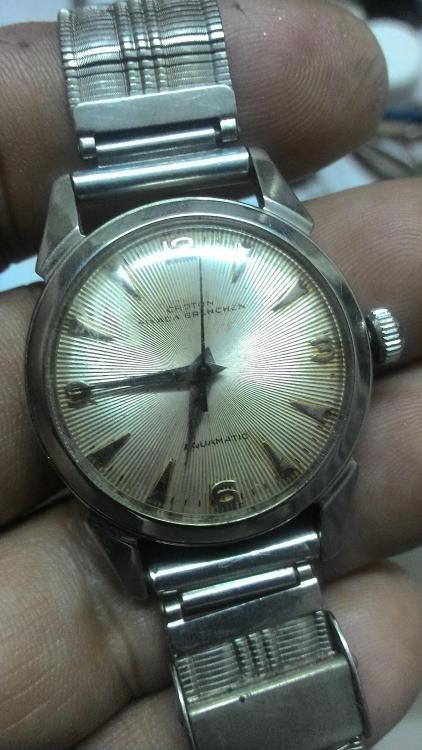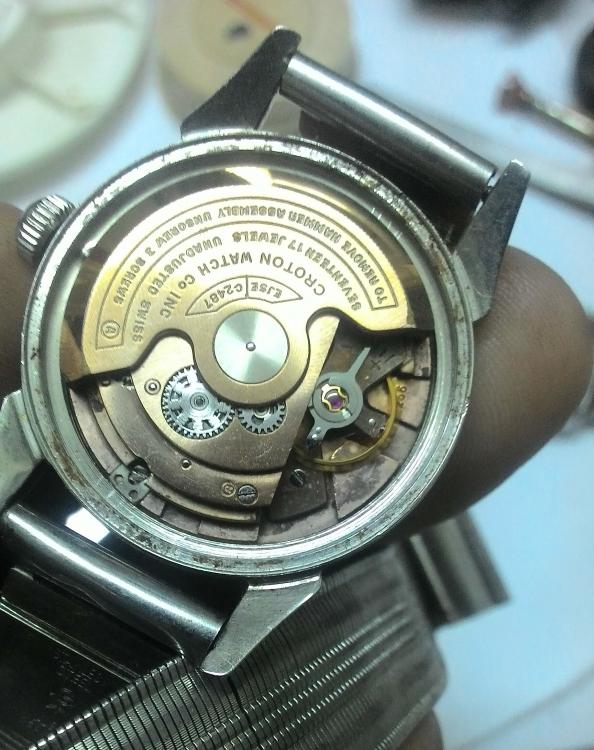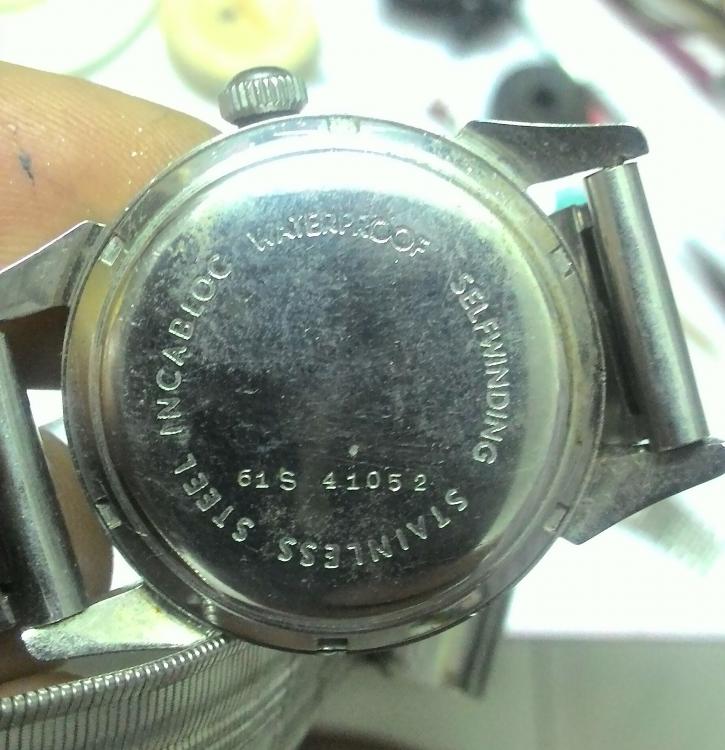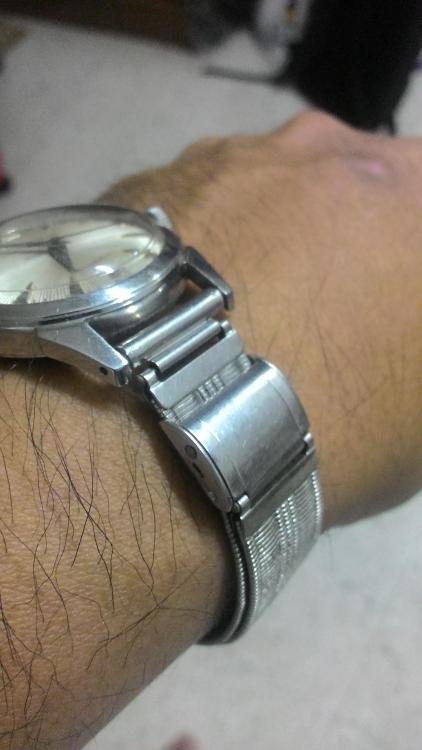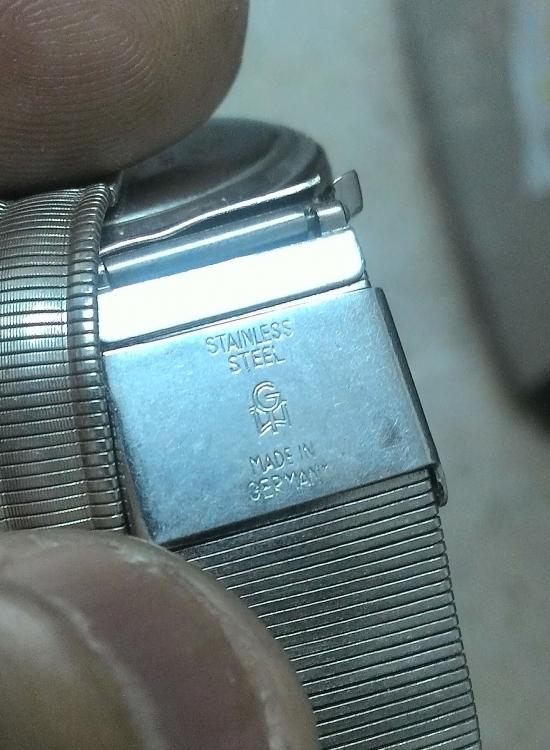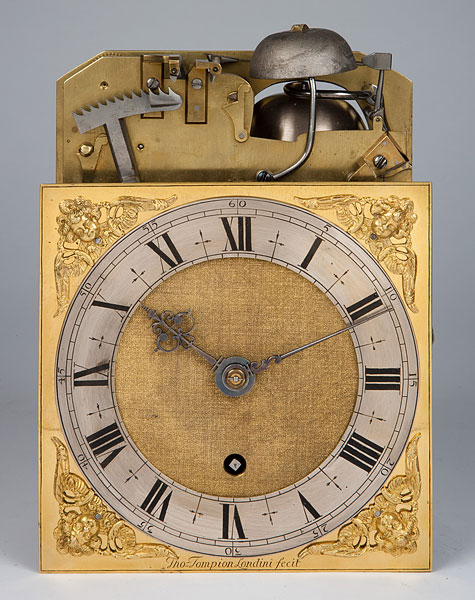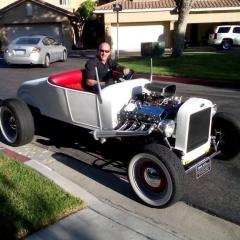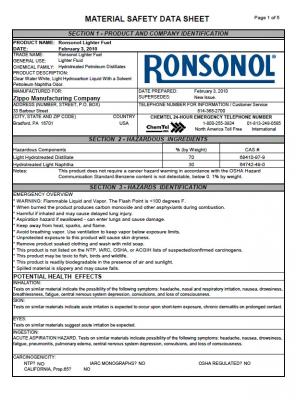Leaderboard
Popular Content
Showing content with the highest reputation on 07/21/17 in all areas
-
If the watch is a divers watch then you will have to remove the movement and maybe also the bezel and remove the crystal and insert a new one with a crystal press the crystal may have or may not have a gasket to form a water proof seal depending on the depth rating of the watch.2 points
-
Morning guys (at least in South East Asia!) Digging thru my collection to find something to wear this Friday I pulled out this. A 'Croton Nivada Grenchen Aquamatic'.. now that's a mouthful, as the actress told the bishop. Inside we find a nicely finished ETA1256 movement. This would be one of the first ETA automatics. ETA kindly provided instructions on the rotor (hammer)... "TO REMOVE HAMMER ASSEMBLY UNSCREW 3 SCREWS 'A' ". Probably they were worried that watchmaker of the day would have problems with these newfangled technology!. Croton were one of the early innovators of waterproofing and they achieved this on early models with a case back that was fastened by 4 screws. These might have worked back in the day but they're just a pain today as the screws are usually badly damaged. This example is a bit recent and has a screw down case back. I wonder is the stamped 61S denotes year of manufacture? Groton watches are not too rare but stainless steel cases are less common and you usually find basemetal cases watches. I've got it on a vintage brand which is super supple and suits the watch. It is similar to a 'bonklip' in function. This is the bandmakers mark. Cheers! Anilv1 point
-
G'day North Australian here. Came here via Mark's excellent videos on YouTube. Watched them all at least once. Looking forward to some more done with his new camera. Not in the business, or a serious hobby guy. But do like mechanical watches, and learning about them and horology in general. Watched a lot of videos online, and read quite a bit of stuff on various forums and sites. Got a few different books, practical and historical. Currently about a third of the way through Revolution in Time, by Landers, which I really like. Gives a solid historical picture of the whole show. Have a couple of basic mechanical watches. A Seagull ST-36 in a stainless case with display back, and a Molinja 3602 pocket watch. Already cased a couple of watches, trimmed a new stem, etc, but would like to get to the level where I can do a basic clean and lube on them every so often. Apart from the oils and one or two basic watch tools, I already have most of the gear needed, plus basic workshop skills with small fiddly stuff from some time at the electronics bench many years ago. Also looking a bit longer term at putting together a nice vintage pocket watch for my father. So slowly learning some of the more practical issues, like what movements go with what dials, which brands and movements have more spare parts, etc. Mostly I will just be lurking and reading, and maybe asking the occasional question.1 point
-
Well where to start, "This clock is a rare exceptional french original brass and champleve style enamel 4 glass regulator mantel clock, it has its absolutely amazing look to it all in great condition for age, the case has a superb original finish to it with only minimal age wear as can be expected" The clock is certainly not of french origin the diamond trade mark was used by a Chinese manufacturer making both clock's and watches in Shanghai, the use of the word regulator is wrong it would depend on what definition of a regulator you would use but this clock could only be wrongly described as a regulator, its certainly not champaleve but he does say style so I will give him that. As for it striking as it should I cant see it doing that at the moment with it set as it is. The movement has a Brocot escapement and the quality of it could only be described as plain "Nasty" a true horror of the horological world made from cheaply pressed out parts and finished by sweat shop workers on a dollar a day. The description reads like a turd polishers dream but at the end of the day its still a turd. It has however attracted a bid for twice what its worth.1 point
-
1 point
-
1 point
-
Only pics will tell which type of crystal you need. No point guessing until we've seen pics. Sent from my Honor 5c1 point
-
If it is a plain domed acrylic crystal then you should be able to push it out from the inside with your thumb with minimal pressure, but will need the above tool to replace. You can usually spot the tension ring type as the ring is quite visible, these need a little more effort to push out, and best replaced with a press. Post some pictures if you need more help.1 point
-
It all depends what type of crystal it is if its a non armoured type then most are held in place with no glue at all they are slightly compressed around the edge when fitting or removing with a tool called a crystal lifter such as the following, http://www.ebay.co.uk/itm/Watch-Glass-Fitting-Tool-Dome-Acrylic-Crystal-Plastic-Lifter-Fitter-Lift-Remover-/271265794833?hash=item3f28b38b11:g:pLAAAMXQHeBSG~Qs I have both a Bergeon lifter and a cheap chinese one off ebay the chinese one is actually more useful as it opens out further and can be used to fit larger crystals on pocket watches the only time I have had to use crystal cement was when I could not find a crystal of the exact size I needed so had to secure it.1 point
-
1 point
-
Heritage does't do it for either... it also reminds me of the Heritage Foundation (a US "conservative" "think" tank, ardent supporters of Donald...) What if you made your logo a bit smaller, so that it's more discreet? I also like Geo's idea about the movement name.1 point
-
1 point
-
That's a shame about the sales results Don, I personally liked your logo. The Heritage one doesn't really do it for me. Have you done any kind of customer surveys see what folk think of Heritage? I like the idea of the name of the movement in small letters above your initials with custom underneath. That way folks would know exactly what the watch is and that it was customised by you.1 point
-
OK - the site is on the new server and an update has been made to the DNS. Hopefully the new IP address will propagate within an hour or so.1 point
-
1 point
-
I can see the use for trimmer watches, the necessity, even. I was just trying to point out the fact that it is £2k (and also really rather large) shouldn't be taken for granted.1 point
-
I think you'll find it's a front loader. The movement and dial is too large to come out the back. The bezel and crystal looks like it should prise off.1 point
-
Hi Tracy, Was the watch running before you cleaned it? These are pretty robust movements but the youngest will be hitting 40 years old or so now. I would relook the balance assembly again. 1. Clean the pivot holes again, inspect against the light. 2. Check the pivots themselves. 3. Check that the hairspring is flat (check with balance installed). 4. On these watches the hairspring is fixed to the underside of the balance-bridge. It needs to be loosened to allow the beat to be set. The screw then needs to be tightened so that it doesn't move. Check that this is not loose. To add to Rodabod's post, If there are problems with the wheels/wheel-pivot/jewels you can remove the balance and pallet fork and wind the watch up a one or two turns. The wheels will start turning fast but as the mainspring reaches the end of its power check to see that it slows down at a constant rate and not in jerks. Once the wheels stop try to push one of the wheels in the same direction. It should not turn further than you push it. If it continues to move after you nudge it this means there is still energy in the spring and something is preventing it from being released fully. In an ideal world the wheels should reverse a bit before it stops totally. Looking at the poor case condition I would say that this is an India watch? These guys go pretty heavy on oiling and I don't think Moebius is commonly used there. Oil on hairsprings is common and easily diagnosed but you also need to check that there is no oil residue in the pinions of the wheels. All the best and keep us updated! Anilv1 point
-
I wouldn't do anything with the watch just yet. Run it on your desk in different positions for a week or so. If the problem persists when wearing the watch, then strip it down. The only difference from the desk and your wrist, is temperature. I suspect something has been over oiled and when the watch on the wrist is warm, something is sticking due to expansion. Over oiling is a common cause of erratic running in a movement, after servicing. Sent from my SM-T585 using Tapatalk1 point
-
The first thing I would do is take it out of its case and see if it runs OK. Is it stopping at the same place, if so check the hands, make sure they are free from obstruction. Run the watch with the dial and hands removed. Are you using the correct screws for the parts? Do exactly as clockboy has said. As it is a two-barrel movement, did you put the barrels back together using the exact same parts as when you took it apart. I know it sounds silly but sometimes it can make a difference.1 point
-
New member but I have been viewing most of the You Tube video's by Mark Lovick which helped me fix my first Seiko watch and since have done minor repair on several watches and gaining on watch tools. It started as a curiosity and now its a beginning hobby with buying more old watches on eBay and repairing them, or I should say attempting to repair them. Only issue I have is the old vintage watches are so f#*%^ small, I have a hard time setting the gear train wheels in their proper places. It takes a steady hand, which I don't have, and eye strain that gives me a headache. So stopping every 15 minutes and resting helps but then I forgot which parts goes where! Damn, getting old is not for wusses. Mark makes everything look so easy but setting the impulse jewel into position for the pallet fork has me pulling my hair out, and not much left. Any secrete or video advising the best or easiest way to do it, would sure be appreciated. Thank you, Rob1 point
-
Hello from Orange County, California! Thank you for creating this site. I have been watching Mark's videos on YouTube for quite some time and I appreciate what you are doing for those of us that are intrigued by mechanical watches. I have had a fascination with pocket watches since a very young age and I love watching your service and repair videos, especially vintage watches of all types. I look forward to learning from this community, and meeting other people from around the world that share my interest and fascination with mechanical watches. Cheers!1 point
-
thanks for welcome. I am an amateur watch restorer/repairer since 60 years. But never too old to learn a few tricks so I hope to learn from the community. What an asset to new watchmakers to have all this data available at a few clicks. I remember many hours standing behind a watchmaker to see what he did and learn, but slowly. But although I (with experience under my belt) appreciate the easy info, i would like to stress to young people to remain eager to go and do! There is no substitute your fingers to learn what to, and how to do it. And that comes at a price, real costs but also the famous sweat and tears. I am dutch, live in france and consider english my best language.1 point
-
Thank you for your welcome, I am a new member from Argentina and I am here to learn! Hi everyone!1 point
-
Thanks for that George, your timing is particularly interesting as apparently you are using the "New" version of the Ronson fluid. Zippo bought them out in 2010 and changed the formula. It now has 30% naptha content. I am using cheap Bull brand fluid which according to the can is just Naptha ? Wonder if there are any Chemist types out there to advise. Anyway, it seems that Zippo lighter fluid is now in Ronson Cans. The main thing is that you have been using it for 3 years so it has to be the new formula and therefore ok.1 point
-
Hi Vic, here's much tuppence worth. For three years I have been using Ronson lighter fuel for initial cleaning to remove the old oil and grease. I wash all parts, including everything to do with the escapement and have never had a problem with dissolved shellac. This may not be good or recommended practice, but from a practical point it works well for me and has never given me any problems. Like you, this is a hobby and I try to make sensible economies where I can. I hope this has been of some of some help.1 point
-
I clean the pallet fork with Neophaline (I think it's the same with your 'nafta') using a soft brush. Then I use a piece of Rodico and clean the pivots and the jewels faces. Be very careful, I managed to make a pallet fork smile at me like a vampire (when I pushed them against Rodico I managed to displace and rotate them by 90 degrees). My advice: apply the Rodico in the horizontal plane, not perpendicular to the pallets. Bogdan p.s.: of course you do not use any kind of alcohol around shellac!1 point
-
No alcohol on shellac,and every pallet fork jewels are glued with shellac. So dont do it! p.s: sent from my s****y phone so sorry for typing mistakes1 point




